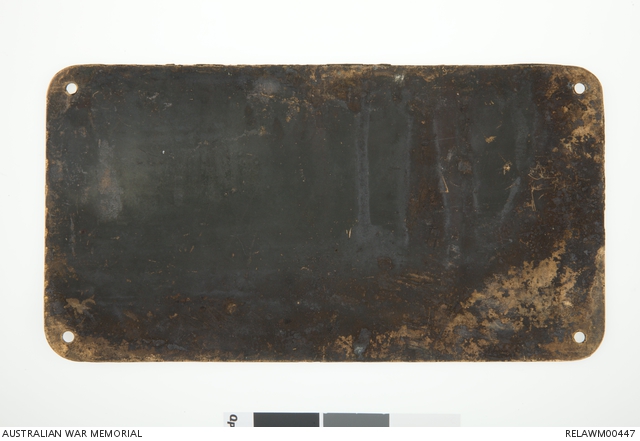| Place | Middle East: Ottoman Empire, Lebanon, Rayak |
|---|---|
| Accession Number | RELAWM00447 |
| Collection type | Technology |
| Object type | Vehicle |
| Physical description | Brass |
| Location | Main Bld: First World War Gallery: Sinai Palestine 1917: Beersheba |
| Maker |
Saechsische (Sächsische) Maschinenfabrik vormals Richard Hartmann |
| Place made | Germany: Saxony-Anhalt, Saxony |
| Date made | 1906 |
| Conflict |
First World War, 1914-1918 |
Railway locomotive brass manufacturers plate : 1 Squadron AFC bombing raid, Rayak


Rectangular cast brass manufacturer's plaque with raised lettering, reading : 'SAECHS. MASCHINENFABRIK / VORM RICH. HARTMANN / ACTIEN-GESELLSCHAFT / 1906 CHEMNITZ. NO 3000'. There is a mounting hole in each corner.
By October 1918, Turkish and German forces were retreating from Palestine towards Damascus in Syria along two or three main routes, including a road which followed the Rayak railway line between Beirut and Damascus. Here, there was a junction of the main standard gauge railway from the Bosphorus with the narrow-gauge lines to Beirut and Damascus, where the Turks had established an aircraft park and huge dumps of ammunition and stores. This busy centre was defended by no fewer than eight 75 mm anti-aircraft guns and on 2 October the centre was targeted by 1 Squadron, Australian Flying Corps (flying 2-seater Bristol fighters). This squadron was part of 40 Wing, RAF, along with 145 Squadron (RAF – SE5a scouts) and 11 Squadron (also SE5as), and was then based at Haifa in Palestine.
On 2 October, between 11:40 am and 13:40 pm, 1 Squadron launched a raid with nine aircraft on troop concentrations, transport and the German airfield at Rayak; they reported that 64 x 25 pound bombs were dropped. Rayak aerodrome was again bombed by a single plane (flown by Pilot Lieutenant PJ McGuiness and Observer Lieutenant H Fysh) on 5 October, during a photographic reconnaissance of the site. The Squadron’s Operational Report notes that when Rayak was subsequently occupied by the 5th Cavalry Division on 7 October, “evidence was found of the material damage that was wrought by our bombs and machine gun fire from the air. No less than 32 enemy machines, including a number of the newest types, were found at Rayak, but the majority had been burnt before abandonment.” At the railway station, which had been burnt out, 200 pieces of rolling stock were counted, many burnt or destroyed, and one locomotive engine, with "no steam". At least some of the destruction noted was undertaken by the Germans and Turks prior to abandoning Rayak, in order to deny its resources to the Allies.
After the Armistice of 25 November, ‘A’ Flight of 1 Squadron took possession of the aerodrome at Rayak and its members souvenired this maker’s plate from the Turkish railway locomotive discovered there. The engine proved to be a 0-4-4-2T Mallet made by German locomotive manufacturer Sächsische Maschinenfabrik, from Chemnitz, Saxony, serial number 3000, constructed and delivered in 1906. Established by Richard Hartmann in the mid-1800s as a spinning machine maker, but quickly expanding into locomotive, turbine and steam engine manufacture, the Sächsische Maschinenfabrik company had heavy involvement in arms manufacture during the First World War, but struggled in the 1920s and was liquidated after the Depression.
This was one of two, possibly three, 0-4-4-2T Mallets that Sächsische Maschinenfabrik had supplied in 1906 to DHP (Société Ottomane du Chemin de fer Damas-Hama et prolongements), the French concern which originally built and owned the branch line from Damascus to Lebanon; this particular locomotive was assigned serial number 961. "Mallet" was a design of articulated tank locomotive developed in 1876 by Anatole Mallet of Switzerland, incorporating a pivoting front set of driving wheels and a fixed set of rear driving wheels. Two sets of cylinders drove the wheels. There are reports that this engine was still running in Syria during the 1970s and 80s.
Rayak is situated close to what is now the Lebanese/Syrian border.
After the end of the war, this maker’s plaque was handed over to the Australian War Records Section.